.
THE MENTOR 1914.09.15, No. 67,
American Mural Painters

LEARN ONE THING
EVERY DAY
September 15, 1914
Vol 2 No. 15
THE
MENTOR
AMERICAN
MURAL
PAINTERS
DEPARTMENT OF
FINE ARTS
Serial Number 67
FIFTEEN CENTS A COPY
The Mentor Association
ESTABLISHED FOR THE DEVELOPMENT OF A POPULAR INTEREST IN ART, LITERATURE, SCIENCE, HISTORY, NATURE, AND TRAVEL
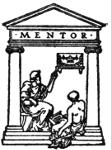
THE ADVISORY BOARD
| JOHN G. HIBBEN | President of Princeton University |
| HAMILTON W. MABIE | Author and Editor |
| JOHN C. VAN DYKE | Professor of the History of Art, Rutgers College |
| ALBERT BUSHNELL HART | Professor of Government, Harvard University |
| WILLIAM T. HORNADAY | Director New York Zoölogical Park |
| DWIGHT L. ELMENDORF | Lecturer and Traveler |
THE PLAN OF THE ASSOCIATION
The purpose of The Mentor Association is to give its members, in an interesting and attractive way, the information in various fields of knowledge which everybody wants and ought to have. The information is imparted by interesting reading matter, prepared under the direction of leading authorities, and by beautiful pictures, produced by the most highly perfected modern processes.
The object of The Mentor Association is to enable people to acquire useful knowledge without effort, so that they may come easily and agreeably to know the world’s great men and women, the great achievements and the permanently interesting things in art, literature, science, history, nature, and travel.
The purpose of the Association is carried out by means of simple readable text and beautiful illustrations in The Mentor.
The annual subscription is Three Dollars, covering The Mentor Course, which comprises twenty-four numbers of The Mentor in one year.
THE MENTOR
SUBSCRIPTION, THREE DOLLARS A YEAR. SINGLE COPIES FIFTEEN CENTS. FOREIGN POSTAGE 75 CENTS EXTRA. CANADIAN POSTAGE 50 CENTS EXTRA. ENTERED AT THE POST-OFFICE AT NEW YORK, N.Y., AS SECOND-CLASS MATTER. COPYRIGHT, 1915, BY THE MENTOR ASSOCIATION, INC. PRESIDENT AND TREASURER, R. M. DONALDSON; VICE-PRESIDENT, W. M. SANFORD; SECRETARY, L. D. GARDNER
Issued Semi-Monthly by
The Mentor Association, Inc.
52 EAST 19th STREET, NEW YORK, N. Y.

THE PLEIADES, by Elihu Vedder. In the Metropolitan Museum of Art, New York City.
American Mural Painters
ELIHU VEDDER
Monograph Number One in The Mentor Reading Course
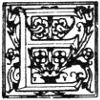
Elihu Vedder said of his parents, “My mother went to church; but I know that wherever a fish was to be found my father went fishing,” and of his mother he said further, “It had always been my mother’s wish that I should be a great artist, and for her sake I wish it could have been so.”
Vedder was born in New York City on February 26, 1836, and as a boy attended the Brinkerhoff School in Brooklyn. In this institution the greatest virtue was a good memory; the pupil who could best memorize his lessons stood highest. Consequently Vedder, who always had a bad memory, stood at the foot of his class. Nevertheless he showed early evidences of his talent.
He first studied under the genre (jonr) and historical painter Tompkins H. Mattison, at Sherburne, New York. Then he went to Paris to study in the atelier of the French painter Picot. He went to Italy in 1857, where he worked for some years, and then returned to the United States and remained there until 1865. In that year he was elected to full membership in the National Academy of Design, New York City. He went back to Paris and spent one winter there; but in January, 1867, moved to Rome, where he has ever since resided. He has made many visits to the United States; but Italy is his favorite dwelling place.
At first Vedder devoted himself to the painting of genre pictures. These, however, attracted only a little attention until 1884, when he illustrated the Rubaiyat of Omar Khayyam. This immediately gave him a high place in the art world. His important decorative work came later. These subjects are principally imaginative.
A pen picture by H. T. Carpenter, of Vedder in his Italian home, gives a good idea of the personality of the man: “The picturesque personality of the painter would impress one, whatever and wherever the surroundings. As he came down those stone steps” (of his studio in Rome), “a bunch of large keys in his hand to open the gate, explaining the while the reason for the absence of the porter and attendant of all work, with a gentleness born of a natural sympathy for the under dog, he looked the man one might imagine the creator of such work as is shown in the series of drawings of the Rubaiyat of Omar Khayyam, or the Congressional Library and the Bowdoin College decorations, or the mural work in the Huntington house, with its incomparable central figure, Luna,—his abundant wavy white hair, features of marked strength, penetrating blue eyes, which alternately twinkled and analyzed, a long, flowing white mustache, a striking head on massive shoulders, tall in height; in fine, a picture of rugged picturesqueness that stood out even in that land of artistic individuality, but never for a moment taken for anything but a fine type of American. His manner was cordial, frank, sincere, and unaffected, and one soon found out he was a good hater of shams.”
PREPARED BY THE EDITORIAL STAFF OF THE MENTOR ASSOCIATION
ILLUSTRATION FOR THE MENTOR, VOL. 2, No. 15. SERIAL No. 67
COPYRIGHT, 1914. BY THE MENTOR ASSOCIATION. INC.

DETAIL OF THE ANTHONY DREXEL MEMORIAL CHANCEL, by E. H. Blashfield.
In the Church of the Savior, Philadelphia, Pennsylvania.
American Mural Painters
EDWIN HOWLAND BLASHFIELD
Monograph Number Two in The Mentor Reading Course

Edwin Howland Blashfield has a place in the front rank of American mural painters through his elevation of thought and his masterly execution. His imagination is fertile and his treatment of subjects highly decorative. He has been able to paint both history and legend, and has placed them side by side in the same compositions.
He was born on December 15, 1848, in New York City. He is a son of William Henry Blashfield, and a brother of Albert Dodd Blashfield, the illustrator.
Blashfield studied first at the Boston Latin School. Then, in 1867, he went to Paris to study under Leon Bonnât. He also received valuable advice from Gérôme and Chapù. He exhibited for many years at the Paris Salon, and also at the Royal Academy in London. In 1881 he returned to the United States and married.
For some years he was a painter of genre pictures; that is, pictures of common life and its associations. Then he turned to decorative work, which was marked by rare delicacy and beauty of color. At the World’s Fair in Chicago in 1893 he painted mural decorations for a dome in the Manufacturers’ Building. Later he did the great central dome of the Congressional Library at Washington, the drawing room for the Huntington residence, the decoration for the courtroom in the courthouse at Baltimore, the decoration of the entire chancel in the Church of the Savior at Philadelphia, and many other masterpieces of mural art.
Blashfield is well known as a lecturer on art, and has written many articles dealing with the subject. With Mrs. Blashfield he wrote, in 1900, “Italian Cities,” and together, with A. A. Hopkins, they edited Vasari’s “Lives of the Painters.”
At one time Blashfield was president of the Society of American Artists. He is a member of the American Academy of Arts and Letters, and many other societies. He makes his home in New York City.
Blashfield has received many honors and medals, including a bronze medal at the Paris Exposition in 1900, a gold medal at the St. Louis Exposition in 1904, a Carnegie prize in 1911, and others.
PREPARED BY THE EDITORIAL STAFF OF THE MENTOR ASSOCIATION
ILLUSTRATION FOR THE MENTOR, VOL. 2, No. 15. SERIAL No. 67
COPYRIGHT, 1914. BY THE MENTOR ASSOCIATION. INC.
Copyright by M. G. Abbey.
From a Copley Print. Copyright by Curtis & Cameron, Inc.

THE APOTHEOSIS OF PENNSYLVANIA, By E. A. Abbey. IN THE PENNSYLVANIA STATE CAPITOL AT HARRISBURG
American Mural Painters
EDWIN AUSTIN ABBEY
Monograph Number Three in The Mentor Reading Course
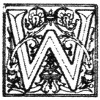
Walk into the Public Library at Boston, and you will find yourself in the midst of some of the most magnificent mural decorations in America. There we find the great frieze of The Prophets, by John Sargent, and in the delivery room is the great decoration by Edwin Austin Abbey which is called “The Quest of the Holy Grail.”
In the early part of his life Edwin Abbey was an illustrator, celebrated chiefly for his pen drawings. In later life his work became larger in character, and he turned naturally to mural painting.
Edwin Austin Abbey was born in Philadelphia, April 1, 1852. He studied first at the schools of the Pennsylvania Academy of Fine Arts; but at the age of nineteen left this and entered the art department of the publishing house of Harper & Bros., New York City, where he became successful as an illustrator. Associated with him were such artists as Howard Pyle, C. S. Reinhart, and Joseph Pennell. In 1878 Harpers’ planned to publish the poems of Robert Herrick, and sent Abbey to England to gather material for the illustrations. These were published in 1882, and attracted much attention. Illustrations for Goldsmith’s “She Stoops to Conquer,” for a volume of old songs, and for the comedies and a few of the tragedies of Shakespeare, followed. His water colors and pastels were successful in the same degree.
Abbey by this time had become closely identified with the art life of England. In 1883 he was elected to the Royal Institute of Painters in Water Colors. His first oil painting was exhibited at the Royal Academy in London in 1890, which was called “A May Day Morning.” He became a full Royal Academician in 1898.
His mural decoration called “The Quest of the Holy Grail,” in the Boston Public Library, on which he was occupied for several years, deserves special mention. In 1901 King Edward VII commissioned him to paint a picture of the coronation. During his life many honors were showered upon him. Abbey died in 1911.
In “The Apotheosis of Pennsylvania,” below to the left are Sir Walter Raleigh, who had a grant in Pennsylvania; Henry Hudson, who discovered and sailed up the Delaware River; Captain Minuit, the explorer and navigator, and others. To the right are a pioneer and representatives of various religious sects that settled in Pennsylvania. Below these, beginning at the left, are ships on the stocks, the city troopers, General Wayne, Atkinson (the first American judge), the first provost of the University of Pennsylvania, Bishop White (the first American bishop), and others, among them Dr. Caspar Wistar, Benjamin Franklin, William Penn, and Robert Morris. At the left are Governor Curtis and Thaddeus Stevens cheering the soldiers of 1861 marching to defend the state, officered by Generals Hancock and Meade. On the right are miners and workers in steel and iron, machinery, and so forth.
PREPARED BY THE EDITORIAL STAFF OF THE MENTOR ASSOCIATION
ILLUSTRATION FOR THE MENTOR, VOL. 2, No. 15. SERIAL No. 67
COPYRIGHT, 1914. BY THE MENTOR ASSOCIATION. INC.
Copyright by Edward Simmons.
From a Copley Print. Copyright by Curtis & Cameron, Inc.

RETURN OF THE BATTLE FLAGS, by Edward Simmons. In the Massachusetts State House. Boston, Massachusetts.
American Mural Painters
EDWARD EMERSON SIMMONS
Monograph Number Four in The Mentor Reading Course

Edward Emerson Simmons had many disappointments to contend with during the early part of his life; but he overcame them all, and has made for himself a place in the foremost rank of American artists.
He comes from good old Massachusetts stock. His mother was a sister of Ralph Waldo Emerson, the famous American poet and essayist. Simmons was born at Concord, Massachusetts, on October 27, 1852. He went to Harvard University, and graduated from there in 1874 with great honor. It is a fact worthy of remark that the class of 1874 contains many men who have achieved distinction.
After graduating Simmons went to Paris to study art, where his teachers were Lefebvre and Boulanger. At the schools he was very popular, and his easel was the favorite loafing place for the other members of his class.
In 1881 he exhibited at the Salon a portrait of a gentleman in Highland costume, which attracted great attention. The following summer he went to Brittany, where he remained for sometime. He made his home at Concarneau in Finistère, a fishing port famous for its sardines. There Simmons experimented with all kinds of painting,—landscape, marine, and figure,—and took the lead in the art life of the colony, among whom were painters from France, England, and America.
In 1882 he sent to the Salon a painting called “La Blanchisseuse,” a picture of a Breton girl carrying the clothes from the brookside, where she had been washing them, which is a custom in Brittany. The picture received honorable mention.
In 1891 his class at Harvard decided to give a memorial window, and Simmons got the commission. Then came the World’s Fair at Chicago in 1893, and Simmons obtained the commission to decorate the dome of the Liberal Arts Building. He chose for his subject four objects of American labor,—wood, iron, stone, and fiber. This painting shows strength, directness, simplicity, and dignity. It was his first mural decoration, and was a good experience. He saw his opportunity and made the most of it.
Almost immediately came the commission to decorate the Criminal Court Buildings of the Courts of Oyer and Terminer in the city of New York, which he worked out with enthusiasm. The subject represented is Justice, in the shape of a stately, dignified figure with a globe in one hand and the scales in the other. He draped this figure in an American flag; a hard problem, but cleverly worked out. The side panels to the right represent the Three Fates; those to the left, Liberty, Equality, and Fraternity.
Then came the commission for decorating the Congressional Library at Washington. He chose as his subject the nine muses.
Following this he received many commissions for work in private residences, and for a series of paintings for the Waldorf-Astoria Hotel, New York City.
Simmons was one of the original members of the Ten American Painters, and is a member of the National Institute of Arts and Letters.
PREPARED BY THE EDITORIAL STAFF OF THE MENTOR ASSOCIATION
ILLUSTRATION FOR THE MENTOR, VOL. 2, No. 15. SERIAL No. 67
COPYRIGHT, 1914. BY THE MENTOR ASSOCIATION. INC.
FROM A COPLEY PRINT. COPYRIGHT BY CURTIS & CAMERON, INC.

HOSEA—DETAIL OF THE PROPHETS, by John Sargent
IN THE PUBLIC LIBRARY. BOSTON, MASSACHUSETTS
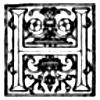
“Hosea,” a detail of the frieze of “The Prophets,” by John Singer Sargent, in the Public Library, Boston, is the subject of one of the intaglio-gravure pictures illustrating “American Mural Painters.”
JOHN SINGER SARGENT
Monograph Number Five in The Mentor Reading Course
John Singer Sargent has been called the most “modern of moderns, one of the most dazzling men of talent of the present day.”
Sargent is in reality an American only by parentage; for he was born at Florence, Italy, on January 12, 1858, and since 1884 has lived in London. Sargent’s father was Dr. Fitzwilliam Sargent, a distinguished Boston physician. Sargent as a child was very sensitive, and was greatly influenced by the art treasures of his birthplace. He received his early education in Italy and Germany, and his impressionable nature amid such surroundings was shaped by the atmosphere of the famous Tuscan city, which left its refining mark upon all his work. The parents of many artists of genius have attempted to dissuade their sons from becoming painters. On the contrary, however, Sargent’s parents encouraged him to draw from the canvases of Veronese, Titian, and Tintoretto.
In 1874, when Sargent was only eighteen, he went to Paris to study, entering the atelier of Carolus-Duran. A portrait of his teacher painted toward the close of his studentship won the commendation of the best judges. He received an honorable mention in the Salon in 1878, and in 1881 a second-class medal for his “Portrait of a Young Lady,” which has been made famous by the appreciation of Henry James, the distinguished American novelist. As an artist with a future he turned his steps to Spain. In Madrid he studied the canvases of Velasquez carefully, and this master has influenced his entire art career. He seemed to come so close to this great painter that he was enabled to bring into the nineteenth century the power of the most modern of fifteenth century painters.
Sargent returned to Paris in 1882 and exhibited “El Jaleo,” a picture representing a Spanish woman dancing, which attracted a great deal of attention, and is now in the Boston Art Museum. Soon afterward Sargent drifted to London, and in 1886 his “Carnation, Lily, Lily, Rose” brought him immediate recognition. He rapidly became known in London as a brilliant portrait painter, and year by year his Academy portraits were the features of the exhibitions. His success was now assured, and his sitters included the men and women of greatest distinction in the literary, artistic, and social life of both Europe and America.
He is best known as a portrait painter; but at the same time he has done much excellent decorative work, and his decorations for the Boston Public Library, “The Pageant of Religion,” among which was the frieze of “The Prophets,” which were completed in 1903, placed him among the leading mural painters of America.
Sargent was elected a member of the Royal Academy in London in 1894, and in addition to this he has won many other honors. And unlike many American artists residing in Europe, he has always retained his directness and independence.
PREPARED BY THE EDITORIAL STAFF OF THE MENTOR ASSOCIATION
ILLUSTRATION FOR THE MENTOR, VOL. 2, No. 15. SERIAL No. 67
COPYRIGHT, 1914. BY THE MENTOR ASSOCIATION. INC.
Copyright 1907 by DeW C. Ward.

THE BENEFICENCE OF THE LAW by Kenyon Cox. In the Essex County Courthouse, Newark, New Jersey.
American Mural Painters
KENYON COX
Monograph Number Six in The Mentor Reading Course
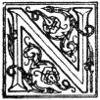
Not only has Kenyon Cox placed himself in the front rank of American artists through his paintings, but he has also made a name for himself as an art critic.
He was born at Warren, Ohio, on October 27, 1856. His father was General Jacob Dolson Cox. He studied art when quite young, first at Cincinnati and Philadelphia, and then at the age of twenty-one went to Paris to study. There for five years he was under Carolus-Duran and Gérôme.
In 1882 he returned to New York and opened a studio there. Shortly after this he began teaching in the Art Students’ League, and had much success in that line. In 1892 he married Louise Howland King, who is well known as a painter herself.
The earlier work of Cox consisted mostly of the nude. He received little encouragement for these pictures, however, and turned to mural decoration, in which he has achieved prominence. His first step toward mural work was the painting of two decorations for the Library of Congress at Washington. In two tympanums (the flat, triangular part of a pediment) each thirty-four feet in length, he has painted the Arts and the Sciences. Among his better known examples are the frieze for the courtroom of the Appellate Court, New York City, and the decorations for the Walker Art Gallery at Bowdoin College, for the Capitol at St. Paul, Minnesota, and for other public and private buildings. His decoration, “The Beneficence of the Law,” in the Essex County Courthouse at Newark, New Jersey, is one of his best-known paintings.
Of late years Mr. Cox has spent much time on wall decorations. He is a maker of pictures and a master of line; but is not an interpreter of life nor an exploiter of ideas.
He is the author of a number of books on art, among which are “Old Masters and New,” and “Painters and Sculptors,” in addition to some poems. He was elected to the National Academy in 1903, and has received many medals and honors.
PREPARED BY THE EDITORIAL STAFF OF THE MENTOR ASSOCIATION
ILLUSTRATION FOR THE MENTOR, VOL. 2, No. 15. SERIAL No. 67
COPYRIGHT, 1914. BY THE MENTOR ASSOCIATION. INC.

Copyright, by Hotel Imperial
Bowling on the Green, by E. A. Abbey. In the grill of the Hotel Imperial, New York City
AMERICAN
MURAL PAINTERS
By ARTHUR HOEBER
Author, Artist, and Critic
THE MENTOR · DEPARTMENT OF FINE ARTS · SEPT. 15, 1914
MENTOR GRAVURES
- RETURN OF THE BATTLE FLAGS
By Edward Simmons - THE APOTHEOSIS OF PENNSYLVANIA
By E. A. Abbey - THE BENEFICENCE OF THE LAW
By Kenyon Cox - HOSEA—DETAIL OF THE PROPHETS
By John Sargent - DETAIL OF THE ANTHONY DREXEL MEMORIAL CHANCEL
By E. H. Blashfield - THE PLEIADES
By Elihu Vedder
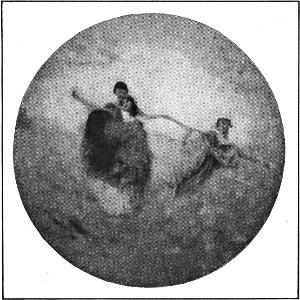
DAWN, by T. W. Dewing
Ceiling decoration in the grill of the Hotel Imperial, New York City
—Ralph Waldo Emerson.
The story of mural painting in America dates back just a trifle over half a century; yet so rapidly do we develop things in this country that today the names of half a hundred men and women who have done distinguished work in this direction come to mind in any review of native accomplishment. However, the art of decoration is one of the oldest in the history of the world, examples of which have been handed down from almost prehistoric times. Traditions reach us—examples too—from the great civilizations of Egypt, Assyria, Greece, Rome, in Europe; while on our own continent there remain records of art in the way of wall decorations in Mexico and Central America, of beauty, taste, and invention, that baffle all efforts to classify as to their age. Says a great art writer, “No society, however rudimentary, has altogether ignored art.” Within the last few years prehistoric paintings by men who probably lived on reindeer flesh have been discovered in caves of the Pyrenees, paintings of no little artistic merit and surely artistic instinct.
With the name of John La Farge must begin any account of the history of mural painting in America. The name is an honored one in the annals of our art development, and he has been dead only a few years, after a long life of devotion to high artistic ideals. It was in 1861 that he completed a panel for the church of the Paulist Fathers, in New York. The theme was “Saint Paul Preaching at Athens.” The architects, however, rejected the work for reasons that seem never to have been recorded, and the next year La Farge began a large triptych[1] of “The Crucifixion”; though he completed only two of the smaller divisions of the composition. These he kept in his studio for many years, until they were purchased by the late William C. Whitney. But his work in the meantime had been remarked, and he received an order for some decorations for a dining room; while the architect H. H. Richardson, in 1876, offered him a commission to take charge of the interior decoration of Trinity Church, Boston. This work was completed in about four months. La Farge chose as assistants Francis Lathrop, Francis D. Millet, George W. Maynard, and Augustus Saint-Gaudens the sculptor, among others. The work was satisfactorily completed, and remains today one of the great accomplishments in this country. After this La Farge was asked to decorate Saint Thomas’ Church in New York, which was followed by his decorations for the Church of the Incarnation in the same city.
[1] A picture on three panels side by side.
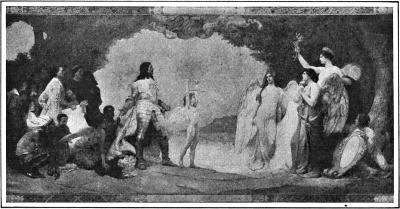
Copyright, 1904
THE EDICT OF TOLERATION, by E. H. Blashfield
This is the central section of a decoration in the courthouse at Baltimore, Maryland
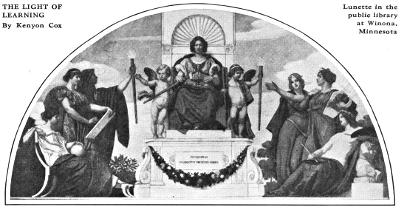
THE LIGHT OF LEARNING
By Kenyon Cox
Lunette in the public library at Winona, Minnesota
LA FARGE’S MASTERPIECE
In the Church of the Ascension, however, is La Farge’s masterpiece, without doubt the greatest piece of church decoration in this country. The theme is “The Ascension of Our Lord,” a composition arranged in two groups, one of the ascending Christ amid the clouds, the other of the disciples with Mary the Mother standing on the ground gazing upon the wonder passing beyond their vision. The composition is one of great dignity and deep religious feeling; the vision of the painter is most distinguished; while there are both balance and harmony, and the color scheme is highly decorative and rich.
The work was immediately followed by many others, including a music room for the residence of the late Whitelaw Reid, rooms in the residence of Cornelius Vanderbilt, and many churches; while later was to come the work for great public buildings, culminating in the decorations for the Supreme Court room of the new capitol at St. Paul, Minnesota, a colossal undertaking comprising many large panels. La Farge did not, however, confine his activities entirely to mural painting; for during his long career in art he was identified with work in stained glass, to which he gave great attention. His achievements in this direction were among the most distinguished that have ever been attained in the history of the world.
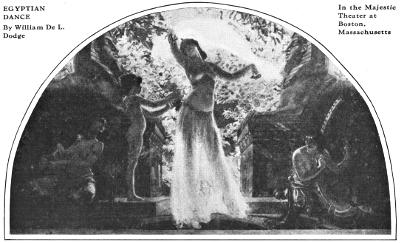
EGYPTIAN DANCE
By William De L. Dodge
In the Majestic Theater at Boston, Massachusetts
WILLIAM M. HUNT
Before we come to the group of present workers in mural painting it is necessary that we consider an earlier man, again one of the pioneers, the artist William M. Hunt of Boston, who in 1878 obtained the commission to decorate the New York state capitol at Albany. The result was a fine series of pictures, well composed; but unfortunately they survive only in reproductions, the originals having been painted directly on the walls. These, owing to faulty construction, did not long remain intact, falling out of plumb, and they had to be supported by beams until they were finally entirely destroyed. Hunt had been a pupil of Thomas Couture (koo-toor´) in Paris, a man who had strong influence on his work, and these decorations were very reminiscent of his master. The pictures were fifteen by forty-five feet in size, and the themes were “The Flight of Night” and “The Discoverer,” of which only photographs remain to tell the tale.
Today the mural painter produces his work on canvas instead of on the wall, a process that enables him to do most of the labor in the studio, and in case of necessity this, after being attached to the walls, can be taken down again and so preserved.
MURAL ART AT “THE WHITE CITY”
It was on the occasion of the planning of the World’s Columbian Exposition of 1893 in Chicago that the first real impetus to mural decoration was given in America. This occasion disclosed to the citizen the possibilities of the native artist, as well as the esthetic value of such embellishment in public edifice and in private home. The administrative body of the fair, determining upon a decorative scheme to be properly carried out, appointed to take charge of the mural painting Francis D. Millet, and as assistant, Charles Yardley Turner. A selection of artists was made to execute the work, who were J. Alden Weir, Edwin Howland Blashfield, George W. Maynard, Robert Reid, Edward Simmons, Charles Stanley Reinhart, Carroll Beckwith, Kenyon Cox, Gari Melchers, William De L. Dodge, and Walter McEwen.
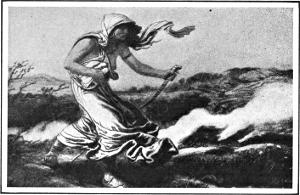
THE CUMÆAN SIBYL, by Elihu Vedder
At Wellesley College
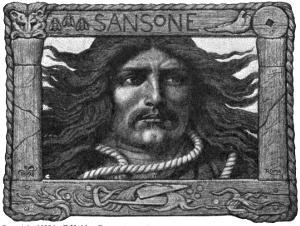
Copyright, 1898, by E. Vedder. From a Copley Print, copyright, 1899, by Curtis & Cameron, Inc.
SAMSON, by Elihu Vedder
Blashfield and Maynard had had some slight experience in decorative work; but the rest were practically novices, though all had been serious, capable students in Paris, and were familiar with examples of the decorative arts of history. Millet was a rare executive, a man who was subsequently to do an enormous amount of just such work. It will be remembered that he went down to his death in the ill-fated Titanic. Of the rest of the group Weir, Reinhart, Beckwith, Melchers, and McEwen returned to their easel picture work after the Chicago fair, with only an occasional decoration. Blashfield, Maynard, Simmons, Cox, and Dodge have, however, continued to be strongly identified with mural work, and these men must receive closer attention. The decorative scheme at Chicago was a remarkable achievement, all things considered, and the grounds were referred to as “The White City,” “The Fair City,” “The City of Dreams,” and finally, alas! as “The Vanishing City”; but in reality nothing like it was ever seen before and probably never will be again.
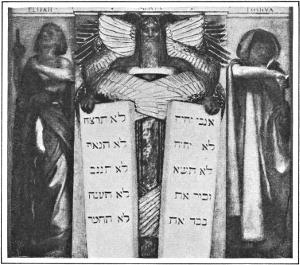
THE PROPHETS, by John Sargent
In the Boston Library. Center panel, showing Elijah, Moses, and Joshua
EDWIN HOWLAND BLASHFIELD
Of this group Mr. Blashfield has been more largely identified with decorations all over the land than the rest. The list of his mural work is a large one. A pupil of Bonnât’s (bo-nah´) in Paris, a writer of great charm, and a most serious student of his profession, Mr. Blashfield brought to his art scholarly endowments of a high order. After his work of decorating the dome of the Manufacturers’ Building at Chicago came a series of commissions to embellish various homes of private individuals,—Collis P. Huntington, the Drexels, the Vanderbilts, Adolf Lewisohn, and others,—with work for the Library of Congress, the Appellate Court of New York, the ballroom of the Waldorf-Astoria Hotel, the Prudential Life Insurance Company of Newark, New Jersey, the state capitols of Minnesota, Wisconsin, Idaho, and other states, with innumerable courthouses at Baltimore, Newark, Hudson County (New Jersey), Youngstown (Ohio), the Federal Building at Cleveland, some schools, and many more. In these he disclosed enormous invention, great facility, a good pictorial sense of composition, and generally a scholarly grasp of decorative requirements.
KENYON COX
Kenyon Cox, likewise a pupil of the Paris schools under J. L. Gérôme (zhay-rome´), has been largely identified with decorative work throughout the land. A distinguished draftsman and a writer on art as well, Mr. Cox is represented with decorations in the Walker Art Gallery, Bowdoin College, in various state capitols and public libraries, in the Appellate Court of New York and other courthouses throughout the Union, and was awarded the medal of honor for mural painting by the Architectural League in 1910. He too is represented in the mural decorations of the Congressional Library at Washington.
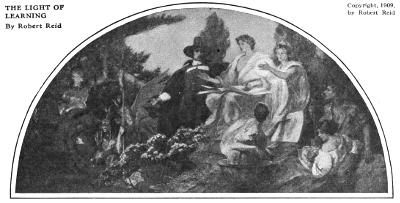
THE LIGHT OF LEARNING
By Robert Reid
Copyright, 1909, by Robert Reid
JOHN SINGER SARGENT
Mr. Sargent, perhaps the most prominent figure in the modern world of art, a man whose success has rarely been duplicated, a painter of the portrait above all, has confined his mural work to the decorations in the Boston Public Library. These are of such superlative quality as to cause regret that the man, in the course of a most active artistic life, could not have found time to do more. Mr. Sargent’s parents were Americans. They are his sole claim to nationality; for he was born in Italy, received his art education in France, and has resided for many years in England. Sargent, in short, is thoroughly cosmopolitan in himself and in his art. His Boston Library decorations are singularly original, of profound symbolism, disclosing deep intellectuality and serious study. His work here, says William A. Coffin, “as a whole is like a casket of jewels.” It consists of a frieze, a lunette,[2] and an arched ceiling. In the latter are depicted the gods of polytheism and idolatry; there are panels of the Prophets in the lunette, and the Jews are represented by twelve nude figures in subjection to the Egyptians and Assyrians, typified by figures of Pharaoh and the Assyrian king. It is a most elaborate symbolism, thoroughly consistent, wonderfully worked out, and of absorbing interest.
[2] A form of decoration over door, window or in arches—shaped like a half moon.
EDWIN A. ABBEY’S DECORATIONS
Edwin A. Abbey, in another chamber of this Boston Library, the delivery room, has his now world-famous decoration, the story of the Holy Grail, perhaps the most popular mural work in this country, certainly the best known, and the shrine for many years of the tourist. It is a series of panels narrating the history of the knights of the Arthurian legend, exquisitely told, for Abbey was a master illustrator, and there is great charm of arrangement and color, all making a popular appeal. Mr. Abbey was further commissioned to decorate the state capitol at Harrisburg, Pennsylvania. He attacked this work with great interest and enthusiasm, but his labors were interrupted by his death. The task was then taken up by Miss Violet Oakley, herself a distinguished mural painter, who, though handicapped by the circumstances of having to follow out the scheme of another artist, nevertheless disclosed great capacity and has made a success of the performance.
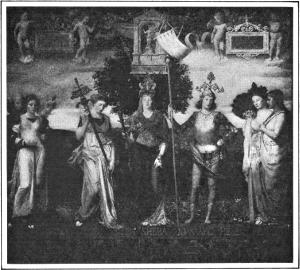
FAMOUS WOMEN, by Barry Faulkner
Decoration for the house of Mrs. E. H. Harriman at Arden, New York. From left to right the women pictured are Cornelia, Beatrice, Judith, Queen of Sheba, Joan of Arc, Helen of Troy, and Pocahontas
PUBLIC LIBRARY DECORATIONS
The Boston Library, it may be stated, offered opportunity for decorative work of an unusual nature, which was taken advantage of by several of the better known men. Elmer E. Garnsey made remarkable designs for the Pompeian lobby, and John Elliott a ceiling in the children’s reference room. The Congressional Library at Washington offered still greater opportunities, engaging the attention of a long list of painters. Here again is seen the hand of Mr. Garnsey, who planned the color scheme; while prominent among the decorations are the works of Elihu Vedder,—six large panels representing Government in its various phases, good and corrupt, of much invention in their allegorical way; for the artist is a highly imaginative man. Mr. Brownell places Vedder in the front rank of the imaginative painters of the day, adding, “Their name is not legion.” Other men who contributed to the Library of Congress include John W. Alexander, who is further represented at Pittsburgh, in the Carnegie Institute, with most important wall decorations; Gari Melchers; Robert Reid, whose list of other work is extensive, including decorations for the capitol at Boston; Henry O. Walker, also represented in the Appellate Court in New York.
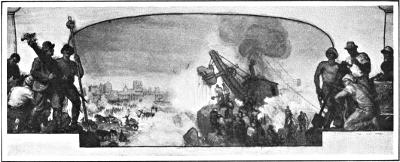
PENNSYLVANIA EXCAVATIONS, by Fred Dana Marsh
EDWARD SIMMONS, ROBERT BLUM, AND OTHERS
In addition to these was a painter who has also been one of the most prominent of the decorative men, Edward Simmons. Years ago he won the competition for a decoration for the Criminal Court room in New York, a prize awarded by the Municipal Art Society. A pupil of the Paris schools, a master draftsman, a singularly capable man, his three panels of the Fates won him instant place, and when he further made two decorations for the Massachusetts state capitol there was opened to him a field which he has since followed with distinction. Decorations for the ballroom of the Waldorf-Astoria, panels for the Appellate Court, for various state capitols and public buildings, and finally enormous embellishments for the Panama fair in San Francisco, place the man in the front rank.
For pure beauty of invention, for charm of drawing and delicacy of vision, no American decoration has surpassed the two lovely panels executed by the late Robert Blum for the frieze of the assembly room of the Mendelssohn Glee Club in New York. They attracted enormous attention when they were first completed, and have been reproduced in many forms. Blum was a highly original painter, and these many figures representing “Music” and “The Dance” have a grace quite their own.
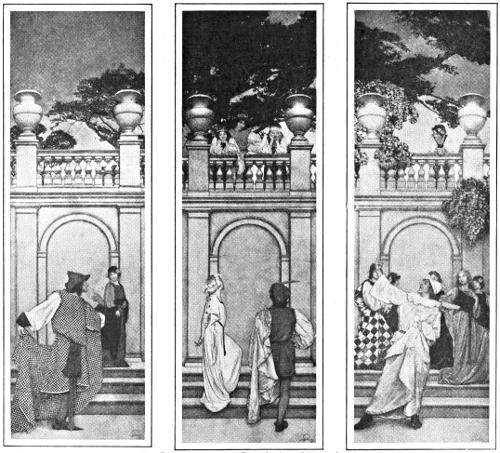
Reproductions of these paintings made by The Detroit Publishing Co.
Copyright, 1912, by The Curtis Publishing Co.
Copyright, 1914, by The Detroit Publishing Co.
THREE PANELS, by Maxfield Parrish
These three panels are part of a series called “A Florentine Fête,” which decorates the entire front of the dining room of the Curtis Publishing Company’s building in Philadelphia
Thomas W. Dewing, more identified with easel work, has nevertheless executed several charming decorations, one in the Imperial Hotel, New York, “Dawn,” ranking high indeed. It has all the man’s personal color vision, and is exquisitely dainty and graceful.
Several men were concerned in the wall decorations of the Appellate Court, among them H. Siddons Mowbray and Willard L. Metcalf. The first named chose for theme “The Transmission of the Law,” which he rendered in a scholarly as well as artistic manner. Mr. Mowbray has executed a ceiling for the library of the University Club of New York, a large work for the Newark courthouse, and many private commissions.
The Waldorf-Astoria Hotel gave early opportunities for the work of Will H. Low and Frank Fowler, both of whom carried out interesting schemes of decoration; while work in the church of the Paulist Fathers in New York offered a similar chance for William Laurel Harris. Fred Dana Marsh showed the possibilities of large engineering achievements for decorative material in a large panel in the rooms of the United Engineering Societies. It is an apotheosis[3] of labor, of the pick, the shovel, and the iron and steel worker, and Mr. Marsh was singularly original in the composition.
[3] An apotheosis celebrates and exalts a subject in ideal forms of expression.
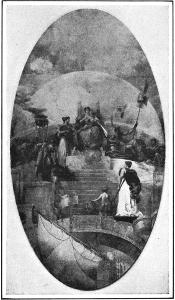
THE CITY OF NEW YORK, THE EASTERN GATEWAY OF THE AMERICAN CONTINENT
By Taber Sears, in the New York City Hall
John W. Alexander, better known as a portrait painter, also chose similar themes with which to decorate the Carnegie Institute of Art in Pittsburgh, a successful piece of work. Robert van V. Sewell, for the home of George Gould, at Lakewood, did a fine frieze representing “The Canterbury Tales.” And a later man is Barry Faulkner, whose panel for the home of Mrs. Harriman, “Famous Women,” is a happy arrangement of the many celebrated feminists. The work of Albert Herter is specially noteworthy. Hugo Ballin has executed large decorative work, and Howard G. Cushing has made strikingly original panels. Other men are Taber Sears, with altar pieces, Joseph Lauber, Charles M. Shean, Douglas Volk, and William B. Van Ingen. Walter Shirlaw occupied himself at times with decorations, and Abbott H. Thayer has likewise executed a few notable mural paintings.
SUPPLEMENTARY READING
- MURAL PAINTING IN AMERICA
By Edwin Howland Blashfield.
Charles Scribner’s Sons, New York. - AMERICAN MURAL PAINTING
By Pauline King.
Noyes, Platt & Co., Boston. - THE HISTORY OF AMERICAN PAINTING
By Samuel Isham.
The Macmillan Company, New York. - THE STORY OF AMERICAN PAINTING
By Charles H. Caffin.
Frederick A. Stokes Company, New York.
THE MENTOR READING CIRCLE
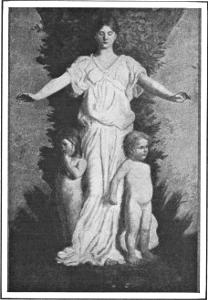
CHARITY, by Abbott Thayer
In the Boston Museum
A mural painting is a decoration intended for the adornment of a wall or ceiling. As a rule, it is painted in more or less simple, flat tones, so as to carry some distance, and under the old methods, known as fresco painting, it was a process of painting in water colors on wet plaster, the portion of the wall on which the artist was to paint being prepared over night, so as to be in proper state to receive the color. The painter had to work from a scaffold. He was also hampered by awkward positions and, frequently, bad lighting facilities. This method was in general use from the early days of Giotto (1266-1337), to those of Raphael (1483-1520). Some of the Italians use it even now.

So mural painting differs materially from a picture painted on an easel. The easel picture has more detail, is placed in a frame when finished, and is destined to make a decorative spot on the walls. The modern mural painter now executes his design directly upon canvas in his studio, and when it is completed it is applied to the wall space by a composition of glue and white lead. When this is thoroughly dry it becomes practically a part of the construction, though it is possible at any time to remove it, by peeling it off, should it be necessary. As a rule, the painter of a great mural work makes first a small sketch. This is subsequently enlarged by himself, or his assistants, by the process of “squaring up,” and so it is brought to the correct size. These enlargements are known as “cartoons,” which are traced on the canvas or the plaster, and when thus drawn in are ready for the painter’s brush.
Almost the first efforts of primitive man in picture making were decorations of the walls of his rude house, and later his temples and public buildings. There are examples from the civilizations of Egypt, Greece, and Rome wherein the work was carried to the greatest perfection. We have splendid specimens of brilliant coloring from the great temples in the land of the Pharaohs, on their tombs and palaces, that have remained fresh and well nigh perfect all these centuries, while throughout Italy, in palaces and churches the work of the Renaissance artists challenges the greatest admiration.

Upon the walls of the buried city of Pompeii still are frescoes that seem painted yesterday, so fresh is the color. The work of Michelangelo and of Raphael in the Vatican at Rome is perhaps the greatest of any known decorative efforts. Throughout France and Germany the work has been greatly fostered by commissions from the state for public buildings of all sorts, for splendid mansions and palaces of royalty. In France, particularly, great attention is given to mural work. The work of the French painter Puvis de Chavannes today is a return, to a certain extent, to the ideals and methods of expression, to the simplicity of theme and treatment of the early masters. He remains by general consent the greatest of all modern decorators, and we are fortunate in America in having admirable specimens of his work in the Boston Public Library. Our modern men, in their mural work, use as a rule oil paints mixed with wax, in order to secure a flat effect and to do away with any reflection on the surface.
Complete Your Mentor Library
Subscriptions always begin with the current issue. The following numbers of The Mentor Course, already issued, will be supplied at the rate of fifteen cents each. Send your list, and the numbers will be shipped at once, charges prepaid.
Serial No.
- 1. Beautiful Children in Art
- 2. Makers of American Poetry
- 3. Washington, the Capital
- 4. Beautiful Women in Art
- 5. Romantic Ireland
- 6. Masters of Music
- 7. Natural Wonders of America
- 8. Pictures We Love to Live with
- 9. The Conquest of the Peaks
- 10. Scotland, the Land of Song and Scenery
- 11. Cherubs in Art
- 12. Statues with a Story
- 13. Story of America in Pictures: The Discoverers
- 14. London
- 15. The Story of Panama
- 16. American Birds of Beauty
- 17. Dutch Masterpieces
- 18. Paris, the Incomparable
- 19. Flowers of Decoration
- 20. Makers of American Humor
- 21. American Sea Painters
- 22. Story of America in Pictures: The Explorers
- 23. Sporting Vacations
- 24. Switzerland: The Land of Scenic Splendors
- 25. American Novelists
- 26. American Landscape Painters
- 27. Venice, the Island City
- 28. The Wife in Art
- 29. Great American Inventors
- 30. Furniture and its Makers
- 31. Spain and Gibraltar
- 32. Historic Spots of America
- 33. Beautiful Buildings of the World
- 34. Game Birds of America
- 35. Story of America in Pictures: The Contest for North America
- 36. Famous American Sculptors
- 37. The Conquest of the Poles
- 38. Napoleon
- 39. The Mediterranean
- 40. Angels in Art
- 41. Famous Composers
- 42. Egypt, the Land of Mystery
- 43. Story of America in Pictures: The Revolution
- 44. Famous English Poets
- 45. Makers of American Art
- 46. The Ruins of Rome
- 47. Makers of Modern Opera
- 48. Dürer and Holbein
- 49. Vienna, the Queen City
- 50. Ancient Athens
- 51. The Barbizon Painters
- 52. Abraham Lincoln: Volume 2
- 53. George Washington
- 54. Mexico
- 55. Famous American Women Painters
- 56. The Conquest of the Air
- 57. Court Painters of France
- 58. Holland
- 59. Our Feathered Friends
- 60. Glacier National Park
- 61. Michelangelo
- 62. American Colonial Furniture
- 63. American Wild Flowers
- 64. Gothic Architecture
- 65. The Story of the Rhine
- 66. Shakespeare
THE MENTOR COURSE TO COME
The next number of The Mentor, to appear on October 1, will contain six beautiful photogravures.
CELEBRATED ANIMAL CHARACTERS
Silver King, Ivan, Sultan, Czar, Gunder, The Bison Herd
By W. T. HORNADAY, Director New York Zoölogical Park
NUMBERS TO FOLLOW
Oct. 15. JAPAN
One of Mr. Elmendorf’s interesting travel articles, full of information about a country that engages the interest of the whole world today. The pictures are varied and most attractive.
By Dwight L. Elmendorf, Lecturer and Traveler.
Nov. 2. THE STORY OF THE FRENCH REVOLUTION
Professor Hart presents in a style that is both scholarly and popular the great drama of French history. There are many volumes treating of single phases, or chapters of the French Revolution, but Professor Hart’s article supplies a real need in picturing in large, simple outlines the great subject as a whole, so that any reader may get a complete impression. The illustrations picture the great personages and important events of the Revolution.
By Albert Bushnell Hart, Professor of Government, Harvard University.
Nov. 16. RUGS AND RUG MAKING
Mr. Mumford is qualified as few are to write on this subject. He has traveled for years in pursuit of the study of rugs, and he is the author of a standard work on the subject. He writes, moreover, in an easy, entertaining, and informing way. The pictures, some of which are in full colors, contribute great value, interest, and beauty to the article.
By J. K. Mumford, Author and Expert on Oriental Rugs.
Dec. 1. ALASKA
One of the most important and interesting travel articles that The Mentor has offered. The writer, Mr. Belmore Browne, knows Alaska more thoroughly perhaps than any living writer and artist. He has been for years an explorer and hunter of big game in the far Northwest, and he is celebrated especially for having achieved the conquest of Mount McKinley together with Professor Herschel Parker.
By Belmore Browne, Explorer, Author and Artist.
The Mentor Service
This service covers the needs of those who want to gain knowledge by an easy and agreeable method.
Send for our booklet descriptive of The Mentor Club Service. It presents many varied Mentor courses specially planned for the use of reading clubs.
The Mentor Association will supply to its members supplementary reading courses dealing with any or all of the subjects in The Mentor Courses. These courses of reading are prepared under the direction of the Advisory Board of The Mentor—all of them prominent educators.
The Mentor Association will also secure books for members, supplying them postpaid at publishers’ prices.
The Mentor Inquiry Department gives to its members a full and intelligent service in answering inquiries concerning books, reading, and all matters of general information having a bearing on The Mentor Courses.
MANY READERS HAVE COME TO KNOW THE VALUE OF THE MENTOR SERVICE. IN THE FULLEST SENSE IT SUPPLEMENTS AND ROUNDS OUT THE PLAN OF THE MENTOR. ALL MEMBERS OF THE ASSOCIATION ARE INVITED TO TAKE ADVANTAGE OF THIS SERVICE
THE MENTOR BINDER
Every page of The Mentor, cover included, contains matter that readers want to keep. The Mentor Association is now supplying to its members a binder which holds twelve or thirteen Mentors and has proved satisfactory in every way. This binder has been arranged so as to hold The Mentor complete and it has tapes to which the pictures are attached, so that they swing freely in their place and the pictures can be enjoyed as well as the text on the back.
The price of these binders is One Dollar each.
MAKE THE SPARE
MOMENT COUNT



